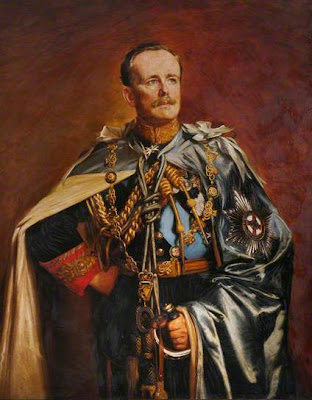This family deduces from
GERARD GORE (c1516-1607), citizen, Merchant Taylor, and Alderman of the City of London at the close of the 16th century, who married Helen, daughter of Ralph Davenant, of Davenant Land, Essex.
He died at the advanced age of 91, having had eight sons, of whom,
RICHARD, the eldest, MP for London, d leaving 7 daughters;The youngest son,
JOHN (Sir), 4th son, Lord Mayor of London, 1624;
PAUL (Sir), of whom presently.
SIR PAUL GORE (1567-1629), captain of a troop of horse, went over to Ireland with his regiment in the reign of ELIZABETH I, and obtaining large grants of land, which he condensed into a manor, designated Manor Gore, settled there.
Captain Gore wedded Isabella, daughter of Francis Wickliffe, and niece of Thomas, Earl of Strafford, and had issue,
RALPH, ancestor of the extinct house of GORE, Earls of Ross;Sir Paul's second son,
ARTHUR, of whom we treat.
ARTHUR GORE (c1640-97), of Newtown, County Mayo, was created a baronet in 1662, designated of Newtown, County Mayo.
He wedded Eleanor, daughter of Sir George St George Bt, of Carrick, County Leitrim, and had (with seven daughters) four sons, viz.
PAUL, predeceased his father;Sir Arthur was succeeded by his grandson (son of Paul),
Arthur;
William, of Woodford, MP for Co Leitrim;
George, an eminent lawyer.
SIR ARTHUR GORE, 2nd Baronet (c1682-1741), MP for Ballynakill, 1703-13, Donegal Borough, 1714-14, County Mayo, 1715-42, who married Elizabeth, eldest daughter of Maurice Annesley, of Little Rath, County Kildare, and had four sons and three daughters,
ARTHUR, his heir;Sir Arthur was succeeded by his eldest son,
Paul Annesley;
William;
George;
Anne; Eleanor; Elizabeth.
SIR ARTHUR GORE, 3rd Baronet (1703-73), MP for Donegal Borough, 1727-58, who was created, in 1758, Baron Saunders, of Deeps, County Wexford, and Viscount Sudley, of Castle Gore.
His lordship was advanced to an earldom, in 1762, in the dignity of EARL OF ARRAN, of the Arran Islands, County Galway.
He espoused Jane, heiress of Richard Saunders, of Saunders Court, and relict of William Worth.
- Arthur Saunders Gore, 2nd Earl (1734–1809);
- Arthur Saunders Gore, 3rd Earl (1761–1837);
- Philip Yorke Gore, 4th Earl (1801–84);
- Arthur Saunders Gore, 5th Earl (1839–1901);
- Arthur Jocelyn Charles Gore, 6th Earl, KP (1868–1958);
- Arthur Paul John James Charles Gore, 7th Earl (1903–58);
- Arthur Strange Kattendyke David Archibald Gore, 8th Earl (1910–83);
- Arthur Desmond Colquhoun Gore, 9th Earl (b 1938).
 |
6th Earl of Arran KP (1868-1958)
|
ARTHUR CHARLES JOCELYN CHARLES [GORE], 6th Earl, KP, PC; Knight of St Patrick, 1909; Privy Counsellor, 1917; Lord-Lieutenant of County Donegal, 1917-20.
The 6th Earl is pictured above, wearing the robe, sash and insignia of the Most Illustrious Order of St Patrick.
 |
Address to 6th Earl and Countess of Arran on their marriage
|
"We, the Tenants on your Lordship's Mayo Estate, and their friends, have heard with the utmost pleasure of your Marriage, and in meeting assembled, unanimously and with sincere and cordial feelings have passed the following resolution ..."
The Earls of Arran were a "Patrick family", the 2nd, 4th, 5th and 6th Earls all having been appointed to the Order of St Patrick.
The present Earl and Countess of Arran live at Castle Hill House, near Barnstaple, Devon.
*****
CASTLE GORE, or Deel Castle, near Crossmolina, County Mayo, is a 16th century tower house of the Bourkes.
It is close to the northern end of Lough Conn.
After Colonel Thomas Bourke had fought on the side of JAMES II in the Williamite War, the property was forfeited and given to the Gore family, afterwards Earls of Arran, who renamed it Castle Gore.
The tower-house had a large 18th century wing with a handsome rusticated doorway added to it, possibly incorporating a 17th century range.
They also acquired the manor of Belleek from the O'Haras, Barons Tyrawley, and owned estates in County Donegal.
The castle along with other lands was leased to James Cuff, Lord Tyrawley, towards the end of the 18th century; occupied by the Cuffs' steward for part of the 19th century.
James Cuff, Lord Tyrawley, built a house beside the Old Bourke Castle in 1791.
The house was burnt in 1922 when the Arrans removed to England. It was not rebuilt.
The old castle, which was still intact in the early 20th century, is now a ruin.
The Earls of Arran's London residence was The Pavilion, Hans Place.
First published in October, 2012. Arran arms courtesy of European Heraldry.



No comments :
Post a Comment